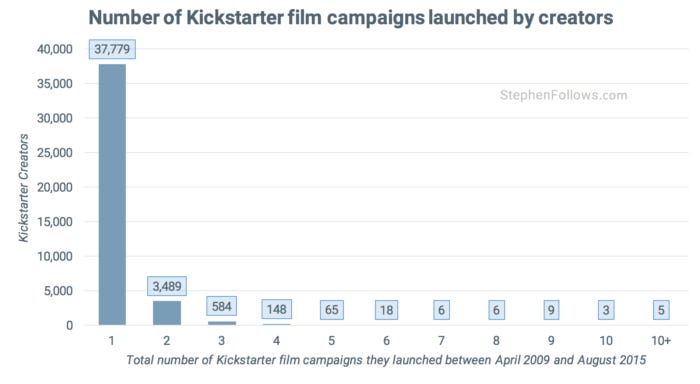How many filmmakers run multiple crowdfunding campaigns?

Crowdfunding provides filmmakers with a much better form of financing than investment or loans. There’s nothing to repay, no one controls the creative process and you own 100% of your film. However, some people question how sustainable crowdfunding is as a repeating funding source. Can you really go back and raise more money on Kickstarter for a second film?
Today’s research was sparked by a reader question. James Heath emailed to ask “Do you happen to know many campaign owners who have gone from running smaller Kickstarter campaigns to returning later to do larger ones?”
In order to work this out, we need a lot of data. Fortunately, last year I performed an extensive study of all Kickstarter film projects which had run since the site’s launch in April 2009 and the summer of 2015. In total, this came to 47,809 projects and the research revealed clear patterns of what works and what doesn’t. You can read about my findings here, here, here, here, and here and if you want a detailed journey through the data then you can join my online course ‘A Crash Course in Crowdfunding’.
How many people run multiple crowdfunding campaigns on Kickstarter?
In order to answer James' question, I went back to this database and narrowed my search to look at people who had run at least two campaigns in the Kickstarter 'film' category. Of the 47,809 projects I looked at, 89.7% came from creators who never ran a second film campaign on Kickstarter.

Fewer than 50 people have run more than five film campaigns and some of the most prolific have been raising very small amounts of money. These include Black Sheep Cinema which ran 11 campaigns during the period I studied, successfully raising an average of $383 per campaign, Gerald Crum (average of $299 across 18 campaigns), Doug Roos (average of $2,426 across 14 campaigns) and Gorman Bechard ($5,424 across 31 campaigns).
Kickstarter recidivists
I narrowed my focus to look only at the first and second campaigns of all the 4,332 people who had run at least one Kickstarter film campaign.
Overall, it turns out that second projects have a higher success rate than that of first projects: 46% versus 38%, respectively. However, when we look at the outcome of the first project, we can see a stark difference in the success rates.
Filmmakers who had run a failed Kickstarter campaign only succeeded 33% of the time with their second campaign. Conversely, if their first project was a success, then they had a 70% chance of succeeding the second time around.

My reading of this is that when filmmakers work out what makes a crowdfunding campaign a success, they can replicate those steps again. Whereas those who fail may not have learnt from their first campaign and consequently, the second campaign makes the same mistakes.
Put simply, successful crowdfunders know why they succeeded, but failed crowdfunders don't know why they failed.
Asking for more or less, second time around
The difference between the two groups (those who succeeded and those who failed the first time around) is actually even wider than the figures above suggest. That's because those who failed on their first campaign tend to set a lower target goal on the second campaign. I've shown previously how there is a (predictable) direct correlation between target goal and success rates, with the smallest campaigns having the higher success rates.
77% of people whose first campaign failed set a lower target goal on their second project, compared to just 37% of those whose first campaign was successful.

28% of people whose first campaign was a success asked for at least three times their original goal on the second attempt.

Getting right back on the (dead) horse
Almost half of the people whose first campaign failed launched a second campaign within three months. By contrast, just over half of successful first timers waited at least a year before returning with a new campaign.
This is probably explained by the successful crowdfunders spending the intervening time making their newly-funded film, although I suspect it also has something to do with successful filmmakers knowing why campaigns succeed (lots and lots of planning) and making sure they're prepared.

Examples of moving to larger projects
Returning to the substance of James' question, in the period I studied, 699 people successfully crowdfunded a film and then went on to successfully raise a larger figure for a second film.

These include:
Erlingur Thoroddsen raised $5,337 to make the short film Child Eater and then went on to raise $15,000 to make the feature film version.
Axanar Productions raised $101,707 to make Star Trek: Prelude to Axanar and then $638,471 to make Star Trek: Axanar.
The short film Spooners raised $8,126 and then went on to raise $16,086 to make a webseries by the same name.
Notes
Crowdfunding projects are rarely run and managed by just one person. Normally there will be one or two people at the top, but under them will be an army of helpers and supporters. Today's research looks at the 'Creator' account linked to each project. In some cases, the account represents a group of people or a company. Therefore, it's conceivable that a company managed two Kickstarter projects but the actual work was completed by different employees. In my research today, this would show up as one person who created two projects.
This research focused on Kickstarter and there are other (much smaller) sites out there. This means that filmmakers could be running second campaigns outside of Kickstarter, and this wouldn't show up in today's research.
Epilogue
I'm grateful to James for his question. It always nice to find new ways to interrogate old datasets and it was a very apt question. I hope the end result helps filmmakers.
If you have a question about any aspect of the film industry, please drop me a line and I'll do my best to look into it.


